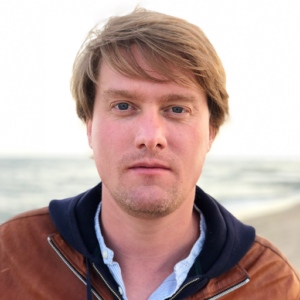Laurent Ballesta has an aquatic gaze. Eyes wide open. Like the Big Blue. Eyes that dream big like the ocean. Like Jacques Mayol and Eric Serra, who showed us what they did just because it was beautiful. After all, isn’t it what life is all about: a pretty boat, an oxygen tank, a mask, and a descent into adventure?
The photographer, a resident of the salt marshes near Montpellier, takes us to see pink flamingos. The path is muddy. It’s drizzling. Lousy weather. “Sorry about the rain,” he apologizes. As if it mattered. At the entrance to his eco-friendly house, which has no drinking water (it needs to be filtered for consumption), there are solar panels, a soil bin, a sort of compost heap, beautiful plants writhing about with charming green balls dangling from the stems. “My daughter calls them ‘poo tomatoes’.” Before we get talking, Ballesta serves hot chocolate, plant-based milk (half spelt half hazelnut), and, of course, financier pastries. A recipe for happiness.
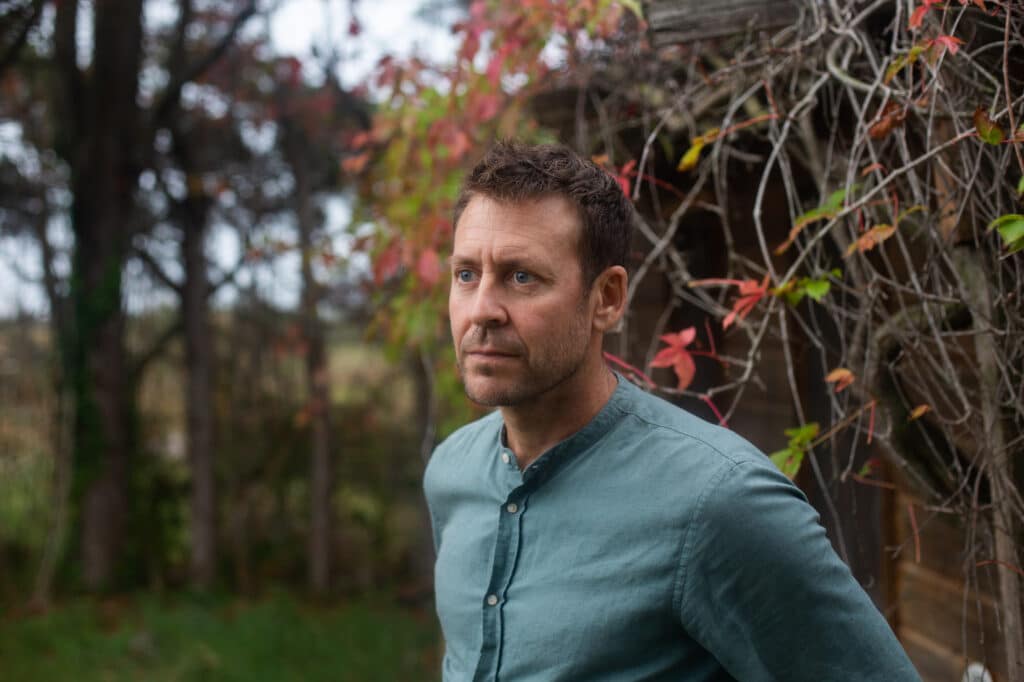
To him, happiness is the deep sea. Ballesta (b. 1974) has been diving since age 13. “I remember those moments like it was yesterday,” he recalls. “Arriving, seeing lines of scuba tanks with regulators sticking out.” His first club was the PTT, 10 francs a dive (nowadays, 50 euros on average). He signed up thanks to his father, a postal worker. His mother worked in a medical analysis laboratory. His family’s passions were Camargue, bullfighting, and soccer. “My father was into soccer. He devoted his whole life to it. Today, he’s 76, and he’s still at the stadium every day. The only thing that brings me closer is not so much the subject, but the fact that I grew up with people who were passionate. Some were passionate about horse-riding; some were passionate about Camargue races; and some were passionate about soccer.”
“When I grow up, I’m going to be a diver.”
At the time, Laurent’s mother was worried that he wasn’t interested enough in girls. Or maybe it was the other way round. Girls don’t know what they’re missing. Rather than talking to his parents about his love life, he told them about his deep blue dreams: “When I grow up, I’m going to be a diver.” They smiled. Diving, to them, was something on TV, a guy with glasses and a red cap talking about his expeditions to around the world. “Something that’s not real. Almost fiction.” The world’s most famous diving spots might often be on the other end of the world, but Ballesta doesn’t need to travel miles to be amazed. “The biggest shock of my life was right here, off the coast of Sète. I was 18. I saw a herd of ten Pellerin sharks. The smallest was six meters long. Until then, all I needed was a crab or an octopus to get me excited. And here, out of the blue, I find myself in the middle of this. I’m like Cousteau! I’m here with these giant animals.”
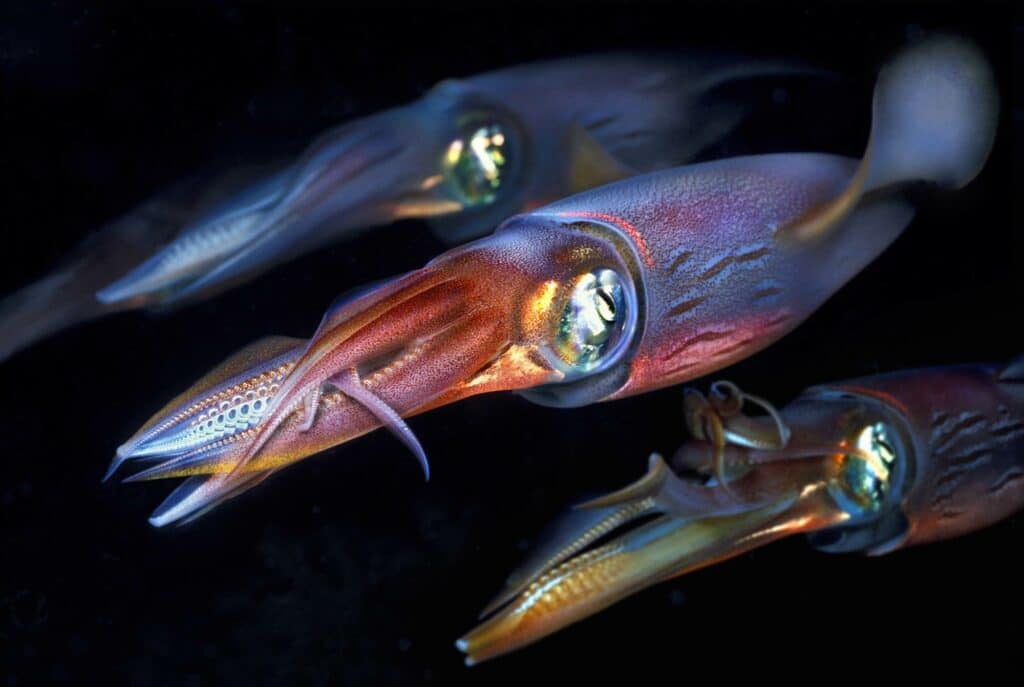
When he came of age, Laurent entered university, majoring in biology and ecology. But the specter of national service, a compulsory replacement for military service, loomed large. “My buddy Pierre and I couldn’t get out of it. There was one alternative: to work for the Ministry of Cooperation, in collaboration with the French Ministry of the Overseas. “We would be away for a while, a year and a half. The list of destinations: Terre Adélie in Antarctica, Kerguelen Islands, and Rangiroa Atoll in French Polynesia.” He would work at the Marine Resources Service at the Rangiroa scientific laboratory, in what is today one of top diving spots, known for dolphin-watching. “I got there by introducing myself at the club of the famous Yves Lefebvre, the greatest diving guide in Polynesia. He started out with nothing but a compressor, a tent, and some Zodiacs. And that was it. To this day, he still has clients who will pay a fortune to spend a week with him.”
Even though Ballesta took up photography almost at the same time as diving, he would always insert entry-level film cameras into watertight boxes cobbled together from PVC glass and pipes to use underwater. But to Rangiroa, Ballesta brought his first real camera, a Nikonos RS, the Rolls-Royce among cameras at the time, purchased for 10,000 francs he had to beg his father for, and which, he was told, would be deducted from his inheritance. He would dive and photograph every single day. His first job: compiling an image catalog of fish larvae.
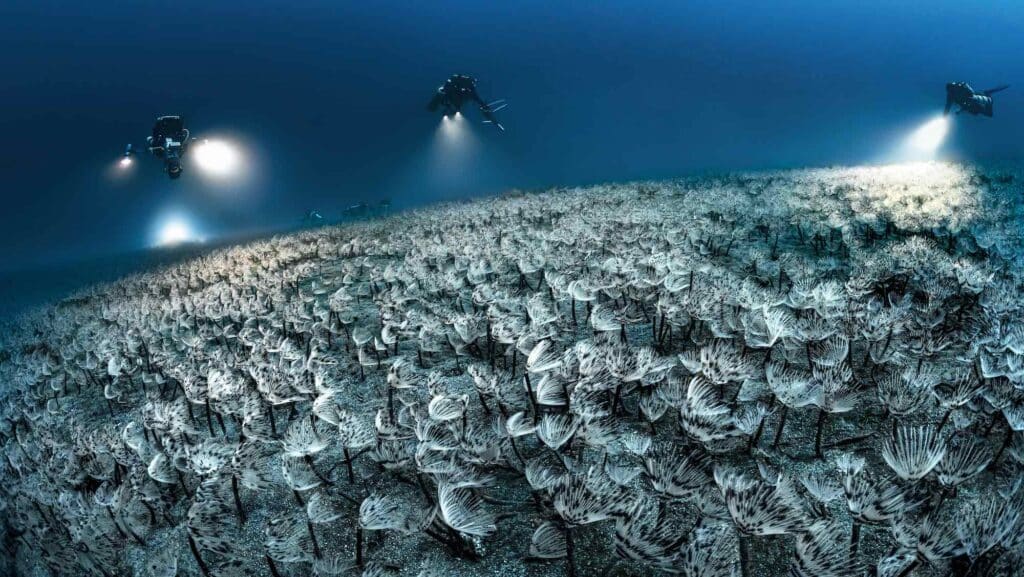
Jacques-Yves Cousteau and Nicolas Hulot
With his woolly red cap and his oceanographic vessel The Calypso, Commander Cousteau stands for half a century of underwater exploration. He left behind a slew of romanticized documentaries, like The Silent World which earned him a Palme d’Or at Cannes in 1956, and an extraordinary legacy in the industry. Jacques Cousteau and Emile Gagnan are in fact credited with inventing the modern demand regulator used in scuba diving. This invention led to the creation of a piece of equipment known as the Aqualung, or self-contained underwater breathing apparatus (SCUBA)—in short, the scuba tank used by divers around the world.
“I studied science, but I was enthralled by Cousteau”
Young Laurent found the man bewitching on screen and adopted him as his role model. “I studied science, but I was enthralled by Cousteau,” he says. “I realized that on board The Calypso, they weren’t scientists, but artists, storytellers, enthusiasts. Likewise, I think my deepest nature is more literary and artistic. As a kid, I used to win drawing contests. I have a scientific background that keeps me from talking nonsense or waxing mystical.”
At Rangiroa, Ballesta didn’t go diving all on his own. He brought along a Corsican girlfriend. On their return to France, she invited him over “to the village.” Corsican culture is more highlands than seaside. He demurred. He wanted to stay by the sea. He would go and visit her family for the August 15th feast in Quenza, in the Alta Rocca region of Corsica, which is also home to someone he admires. “Does Nicolas Hulot live here?” She replied: “Yes, we see him around. I ran into him just this morning at the bakery.” Ballesta asked his girlfriend, who then asked someone who knew someone who knew… “You tell him I sent you. Be at the café at 7:15.” Ballesta showed Hulot his photographs of Rangiroa, and relayed Yves Lefebvre’s greetings. Hulot replied: “There’s nothing more boring than looking at slides. Come over to my place tomorrow.”
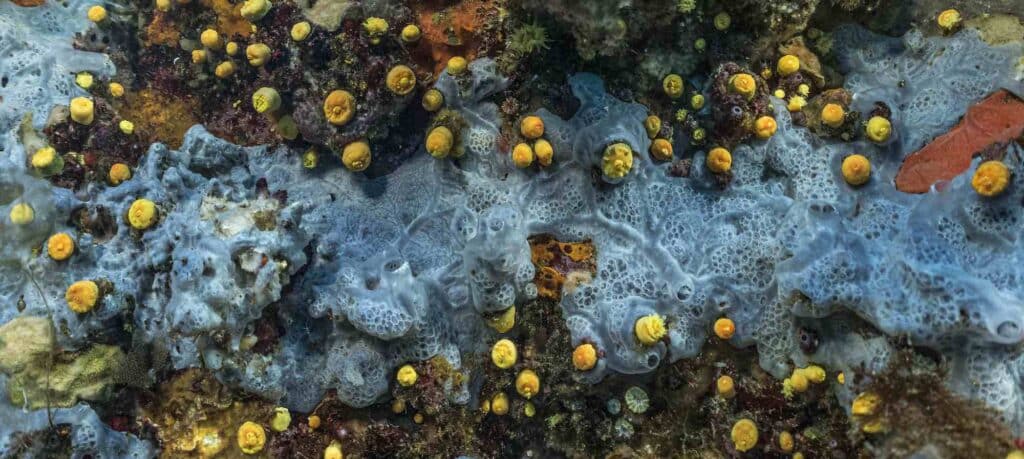
Three days later, Ballesta, then an unemployed student, got a phone call. Next thing he knew, he was on his way to New Zealand, as a scientific advisor on a location scouting trip with a TV crew making of a film for Ushuaïa TV. He would trail Nicolas Hulot for twelve years, until the TV series came to an end in 2014. “Nicolas helped me get my foot in the door.” Around that time, the ecologist also penned an article on the oceans for Paris Match, and had it illustrated with photographs by Laurent Ballesta, endorsed by Guillaume Clavières, the magazine’s photo director.
Four years later, the diver-photographer found himself in Antarctica with Sebastião Salgado, on board The Tara: “Me in the water, him on the boat.” Talking about his relationship with the Paris Match team, Salgado told him: “At Match, if you’re the best, you don’t stick around. Your buddy must be second best. Go and talk to Olivier Royan.” And so Ballesta’s photos exploring the flora and fauna around his native Sète got published in the weekly.
To date, Ballesta’s work for Paris Match totals 240 pages of underwater photos. Not to mention numerous other contributions, in National Geographic as well as diving and nature magazines.
“I have nothing against docu-fiction as long as it doesn’t lie”
Just as Ballesta, then aged twenty-five, was beginning to work on a regular basis on Ushuaïa film shoots, he and his college buddy, Pierre Descamps, set up an association called L’Œil d’Andromède. His first major project, done as a public commission, was about life around the artificial reefs stretching from La Grande-Motte to Villeneuve les Maguelone, in the Hérault region of France.
Today, Ballesta is well known for his photographs in international magazines, his several Wildlife Photographer of the Year awards, his partnership with the Nikon brand, his collaborations and roundtable discussions with photographer Vincent Munier and astronaut Thomas Pesquet. But, in recent years, his name has been associated above all with many acclaimed films, including The Coelacanth (2014), which documents the search for the eponymous fish that inhabits ocean depths between 100 and 400 meters; Antarctica: Sur les Traces de l’Empereur (2016), which shows the diver exploring the underside of ice; or yet 700 Sharks (2018), which follows a reunion of as many sharks in the southern channel at Fakarava.
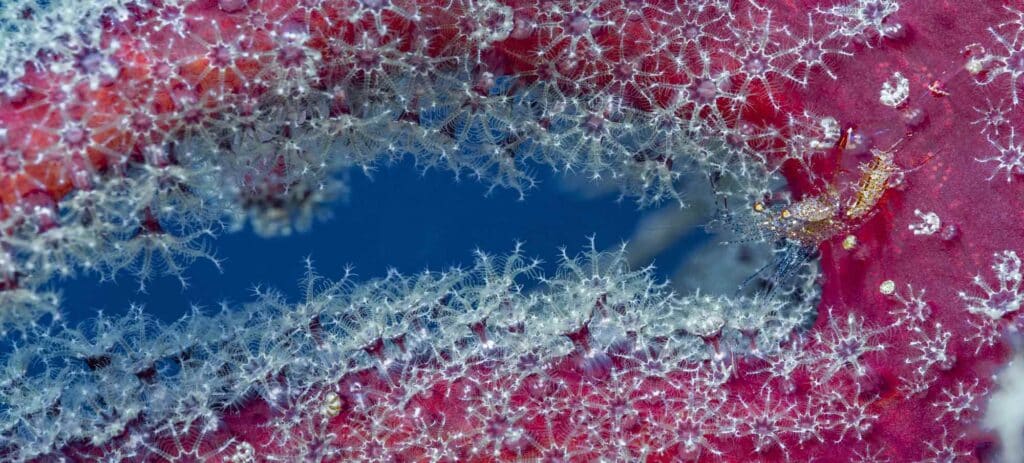
His most famous film is Planète Méditerranée (2020), with a budget of 2.7 million euros. Here we see Ballesta and three other divers out at sea, somewhere between Marseille and Monaco. For 28 consecutive days they inhabit a chamber pressurized to the equivalent of 100 meters’ depth. This enabled them to explore this deep-sea zone at long intervals, and uncover the natural treasures of the Mediterranean. A similar technique of deep-sea diving has been used since the 1980s by divers employed on oil rigs.
Ballesta, who asserts his films’ “authenticity,” is highly critical of the wildlife documentary film industry and the big productions financed by Netflix, Discovery Channel, and National Geographic Wild. Among other things, he describes how certain emotional sequences are manufactured start to finish: “An orca attack on a great white shark, for example. You see the orcas, then the shark, then the orcas, then the shark, then the orcas, then you see red, and wham wham wham. Except there’s never been an attack.” Another film, far less spectacular, yet very tender, is also exposed, namely My Teacher the Octopus (Netflix, 2020): “They created a relationship with this octopus out of thin air. There was no such thing. This was a script written by a screenwriter. The main character went swimming every day like a clockwork, but he never saw a single octopus, he saw octopuses. It’s not the same one every time. This is bogus. I have nothing against docu-fiction, as long as it doesn’t lie.”
Ballesta describes the world of wildlife documentary as highly competitive—at the antipodes of the fascinating image it inspires among the general public. “I sometimes get messages like: ‘Mr Ballesta, we’d love for you to make images of coelacanth predation.’ Just that. They write the menu, and you’re supposed to deliver the dishes. There’s a whole crazy list of things, and they’re hoping I’ll say: I’ve got this in stock; I don’t have that, but I can make it. That’s how things work: they’re on the lookout for videographers, any naturalist who can make beautiful images.”
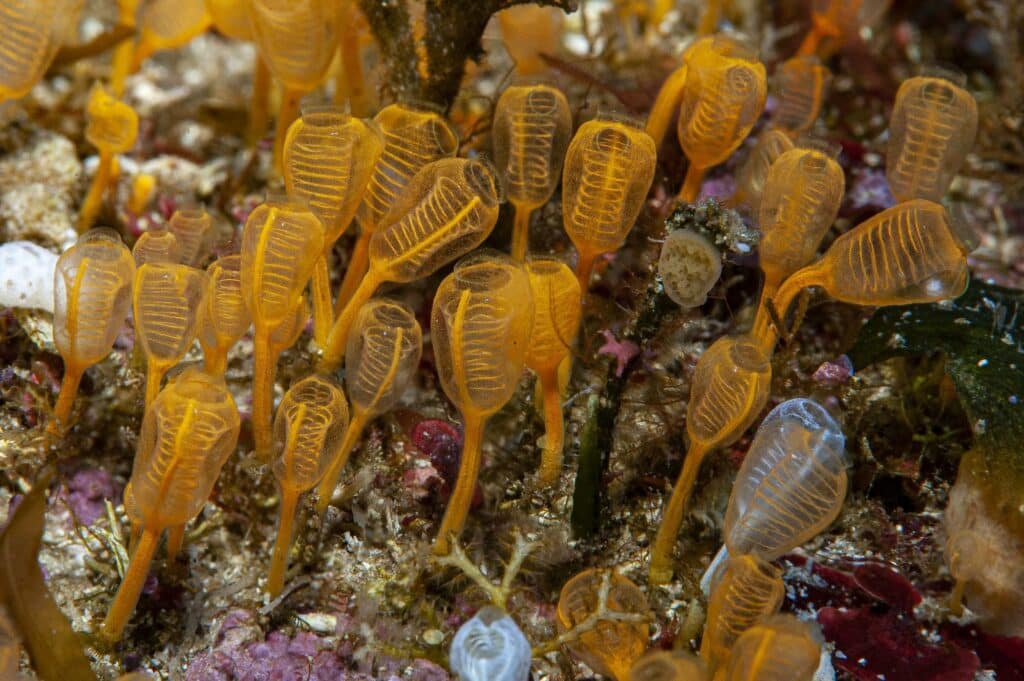
Artisan photographer
Laurent Ballesta is on a quest. His goal: to capture the mystery of the underwater world through a scientific study and the challenge of deep-sea diving, “because if it has remained a mystery, it’s because there’s something inaccessible to ordinary diving.” He had to come up with new ideas and outdo himself. When discovery is just at his fingertips, yet at depths most of us wouldn’t be able to withstand, the photographer reacts in a particular way: “There’s this moment of bedazzlement, the searing intensity of discovery. Because, really, it just falls into your lap like magic. I’d even use the word awe. It’s a moment when everything stops, followed by extreme concentration.”
“Underwater, I’m a cosmonaut”
But who is Laurent Ballesta? “Underwater, I’m a cosmonaut,” he says. In Planète Méditerranée, he describes himself as an “aquanaut” who leaves his “bathyal station” (named after the bathyal zone, which in oceanology refers to depths over 200m.–ed.) to explore the seabed. The man is also a great fan of science fiction. His three absolute masterpieces of recent years: Interstellar (2014); First Contact (2016); and Ad Astra (2019). What he loves about these films is the exploration of distant worlds. Going into space? “If I get the chance, but I’m not even looking for it. I’m not Thomas Pesquet, though, he’s a machine.”
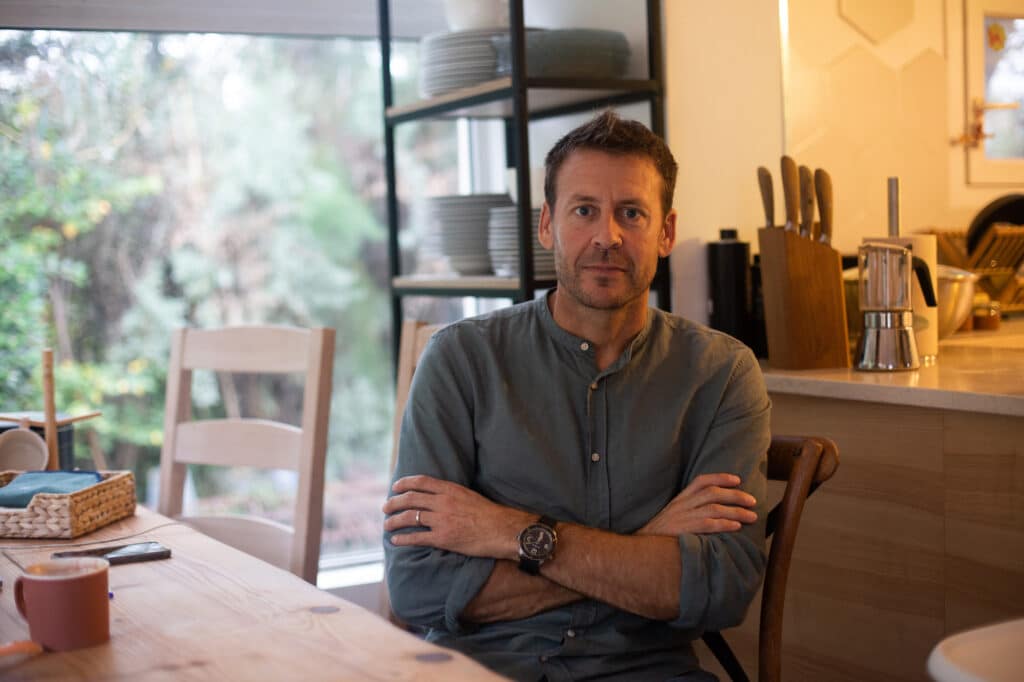
But Ballesta is already an explorer, an exceptional diver, a photographer, and a documentary filmmaker, and that’s not too bad. We’d be happy to add an artist to his credits, a title he rightfully claims, given his commitment and his skill as a storyteller. “I’m not a researcher. What interests me is setting up research and then going on adventures. My job today is to be a craftsman photographer.” And so he recounts one of the greatest scientific absurdities: for an unknown species to be listed by science, a photo is not enough, you need a specimen of the animal. “That’s the rule. The beast in a jar of alcohol. I’m not going to spend an hour at 100 meters trying to make a sublime portrait of an animal and, once I get the right photo, kill it and go home.”
At a time when the planet’s ecological future is at stake, when some people are seeking to flee our planet and colonize others, it’s worth remembering that although the oceans cover 70% of the Earth, barely 25% of the ocean floor has been mapped. And the regions explored by humans add up to even less. There are remote places where much remains to be inventoried: Laurent Ballesta cites northern Papua; Kerguelen, where he would like to start a project; and the islands of Saint-Paul and Amsterdam, which are still French territories. “A species disappears every 20 minutes. According to the latest WWF report, 67% of vertebrates have disappeared over the past 40 years. That is monstrous. This means that, with each passing day species vanish forever, without us having even known of their existence or documented them. So, frankly, when I come across something I’ve never seen before, of course I photograph it. It’ll come in handy sooner or later.”
Books:
Mer: 100 Photos pour la liberté de la presse, Reporters sans Frontières (RSF) album no. 73, with contributions by Laurent Ballesta, Catherine Chabaud, Line le Gall, Claire Nouvian, and a foreword by Baptiste Morizot, €12.50 (in French).
Laurent Ballesta, Mediterranean Planet, Editions Hemeria, 69€ (French/English).

